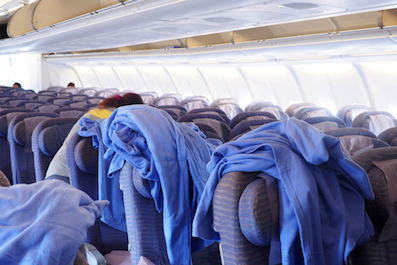 Cleanzine: your weekly cleaning and hygiene industry newsletter 18th April 2024 Issue no. 1110
Cleanzine: your weekly cleaning and hygiene industry newsletter 18th April 2024 Issue no. 1110
Your industry news - first
The original and best - for over 20 years!
We strongly recommend viewing Cleanzine full size in your web browser. Click our masthead above to visit our website version.
How do you clean a plane?
 It's more than forgivable to go about your daily life with no consideration for how things that pass you by are cleaned or maintained. But what if cleaning unusual - and everyday objects - was a cool, more epic job than you once thought and in fact worth marvelling at?
It's more than forgivable to go about your daily life with no consideration for how things that pass you by are cleaned or maintained. But what if cleaning unusual - and everyday objects - was a cool, more epic job than you once thought and in fact worth marvelling at?
Here, Newcastle professional cleaning services provider DCS Multiserve, begins a series on how to clean - well - big or unusual stuff. The first? A plane!
Why is cleaning a plane so important?
When a plane flies from place to place, bacteria is picked up from both the inside and outside of the plane. Unfortunately, the bacteria on the inside is due to people using the aircraft every day; MRSA, E- Coli and others can last for days. That's why cleaning the inside of the plane is so important.
The outside needs a thorough clean too, but for different reasons. The conditions the planes fly in must be considered - with rain, bird excrement and debris from bugs, as well as oil from the hydraulics systems and other residue caused by the engines in flight all likely to be encountered during a flight.
The build-up of all of this debris can cause a drag, which has an impact on fuel economy and can have both financial and safety implications.
How do you clean a plane?
Planning is essential - airlines want the turnaround of customers to be as swift as possible to meet tight times and targets, so planning and priorities are key. Some airline companies use real-time data to determine when aeroplanes are arriving - and at what time - so they can be ready to spring into action. The performance of the cleaning team can also be tracked in real-time to make sure every minute counts.
The process of cleaning a plane varies depending on the type of aircraft though, as well as whether the flight is/has been long or short-haul, when the plane last had a thorough clean and several other factors.
In the cabin:
Turn clean: A 'turn clean' is reserved for times when it's not possible to give the plane a thorough clean - if there is a swift turnaround between flights, for example. Certain areas are targeted as priority, in particular Business and First Class, rather than Economy, alongside the galleys and toilets. The rest of the plane gets a vacuum and litter-pick.
Remain Overnight (RON) clean: A more thorough clean that can take place when the plane is parked overnight at an airport.
Deep clean: A deep clean is a full and complete clean of the cabin, the procedures of which vary from airline to airline. Even on deep cleans, cleaning crews work to a tight schedule for every flight.
The toilets are a priority focus after every flight whatever the type of clean, ensuring when possible that they are cleaned and emptied. The inside of the toilet requires special products and takes less than 10 minutes per toilet - the exterior takes another 10-15 minutes. The waste is emptied by a lavatory truck, which also refills it with clean fluid.
The plane's exterior:
How often is the plane washed?
Travel Skills asked a number of airlines, with varying responses. United Airlines was every 50 days, but for British Airways it depends on the type of aircraft, but usually every six to eight weeks, with short haul flights getting more cleans due to them having more take-offs and landings. Singapore Airlines are washed monthly, with additional washes for dirty spots.
Many companies use pressure washers of varying strengths and scales, with tow-behind pressure washers being used to wash larger aircraft - although this should be confirmed before proceeding.
The tail of the aircraft needs the most attention, as it gets the dirtiest during a flight. Cleaning a plane begins with the tail, and it is worked on in a top-to-bottom direction. From the tail, work across the plane and to the nose. Clean small areas at a time while standing on a working platform, as the pressure of some washers can knock you off-balance.
The use of detergent is essential, especially around the engine, where there will be a lot of black residue caused by the exhaust. With hard-to-remove spots, rotating brushes are also used.
The wheels are washed with a lot of detergent, a brush and pressure washer too. Windows can be done - sometimes by hand - and some pilots even like to do this themselves.
The whole plane is rinsed in clean, cold water as well.
Sources:
www.bbc.com
www.ultimatewasher.com
travelskills.com/2014/10/31/often-planes-get-baths/?
T: (0191) 216 9000
E: [email protected]
W: www.dcsmultiserve.co.uk
17th November 2016







